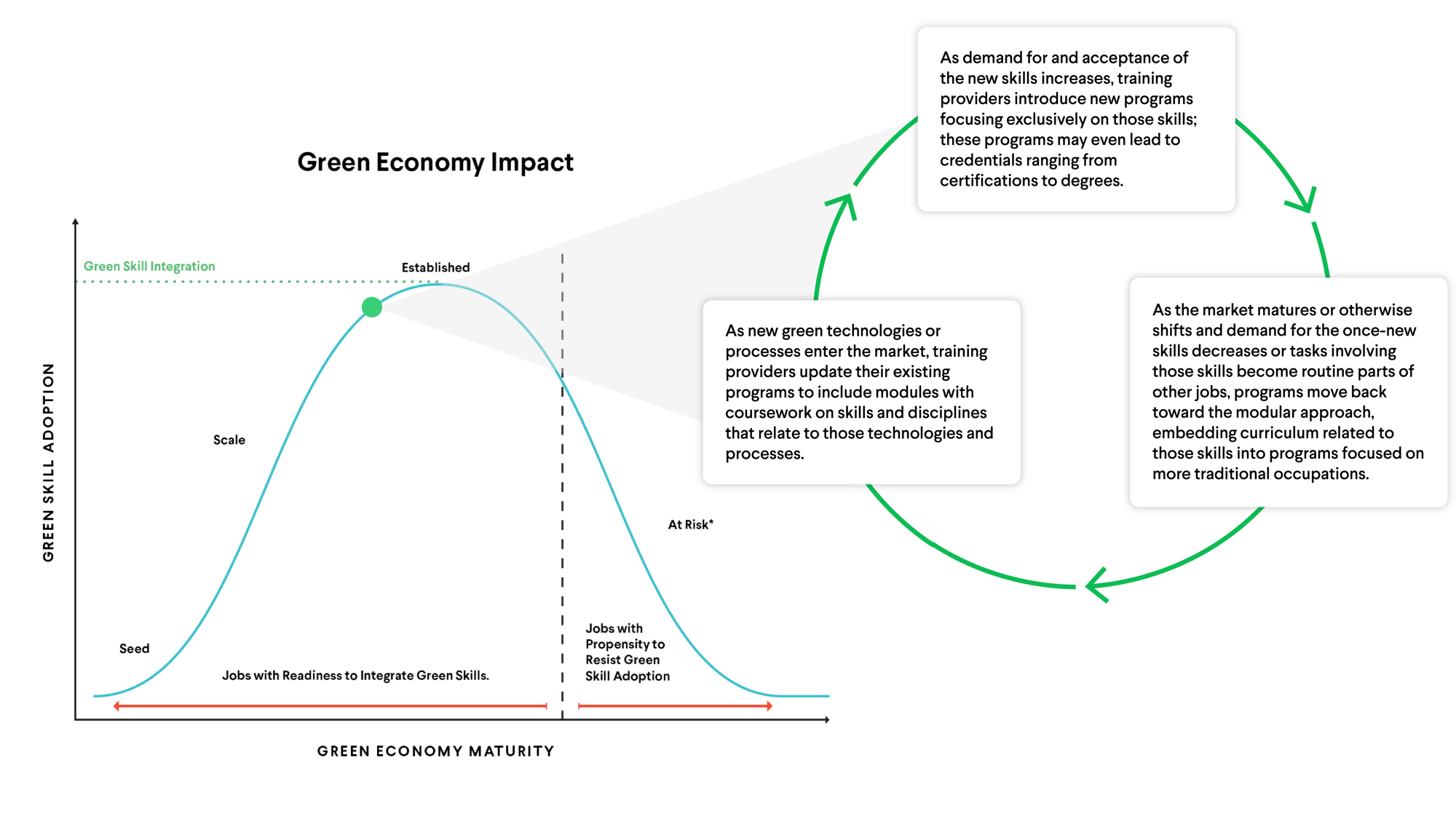Training Viability
The question of what subjects and skills training programs should cover is inexorably tied to the question of pedagogy—in other words, how they should train people. Program leaders we spoke to explained that when they face shifts in the skills and expertise employers are seeking, they usually must choose between creating a new training program (a “programmatic” approach) or adding a new training module to an existing program’s curriculum (a “modular” approach).

- Programmatic approach: An organization chooses to launch an entirely new training program. This approach offers a fresh start, but it involves considerable upfront costs, including equipment and curriculum design, in addition to ongoing costs like facilities and staffing.
- Modular approach: An organization chooses to keep its existing program structure intact but shifts the focus. For example, a training provider might move from a broad focus on energy efficiency and begin specifically emphasizing decarbonization, or an organization that offers short-term training programs might move to a longer-term apprenticeship model.
These decisions are often not permanent. Several people we spoke with said their organizations had changed their approaches several times over the years as they weighed which models were more financially viable and which instructional approaches were more effective, as measured in terms of the employability of their graduates.
The bottom line is that training providers want to ensure that they not only help students learn the material and acquire new skills but also put their students in a position to find good jobs and enter long-term careers with employers that need those skills. Organizations are willing to shift their approaches as needed if that’s what it takes to achieve both goals. (See here for examples of skills that could either be taught in standalone programs or integrated into an existing curriculum.)
As the graphic below illustrates, the process of integrating skills into curricula while responding to market changes can lead training providers into a cycle that can shift back and forth between the modular approach and the programmatic approach.

Julie Hugo, who spent 30 years working at a single manufacturing company and is now director of customized training and development services at Clackamas Community College (CCC), offered this perspective on employers’ ever-changing needs for skills and expertise: “The jobs change,” she said. “You come in as an electrician or a machinist but are expected to do a little bit of welding, a little bit of electronics.”
That recognition of the fact that workers will need to acquire a wide range of skills over the course of their careers has informed CCC’s approach to its course offerings. The college’s renewable energy program includes courses on electronics engineering and industrial maintenance. “If you looked at the core set of classes that a student would be taking in renewable energy, you would see that they’re taking some renewable energy technology classes, some industrial maintenance courses, some electronics engineering courses,” said Armetta Burney, dean of CCC’s Technology, Applied Science and Public Service division.
In a similar vein, CCC has also diversified its portfolio of “green” training programs to match changing demand. Students aren’t tied to studying only wind or solar or alternative fuels or another topic, for example. They have an opportunity to pursue coursework under the entire umbrella of technologies that are available. “Industry partners were excited that students weren’t tied to one of the seven renewables—they gain skills to work across the entire industry,” Burney said.


At Rising Sun in Oakland, an employee said that when it comes to preparing people for green jobs and other roles that involve emerging technologies, “the best thing you can do as a training provider is to provide foundational skills training and career adaptability.”
Rising Sun found the common elements in the curricula of all its “green” programs and built one green lesson into every technical training course. That approach is evident in its Climate Careers program, which is designed to help young adults understand that “there is a place for [everyone] in the green economy because all jobs are going to be climate jobs at some point or impacted in some way by climate,” the employee said. Rising Sun’s Opportunity Build pre-apprenticeship program has adapted to provide one week of training focused on green construction skills that are applicable across several industries.


To remain competitive locally, Eric Hill, CEO of Youth Workforce Development Foundation in Illinois, said his organization ensures that programs are training for all skilled trades, not just “green jobs.” This could include coursework covering a number of clean energy topics, particularly as graduates may fluctuate between installing solar panels one day and traditional roofing the next.
Similarly, Seattle Jobs Initiative offers foundational electrician training that can lead to opportunities in the electric vehicle industry but also prepares students for a wider range of electrical occupations.
This approach can also be helpful for programs in which people learn new skills so they can move into new occupations. An employee at the Michigan Workforce Training and Education Collaborative (MWTEC) estimated that only about 10% of the skills required in battery manufacturing differ from those required in traditional manufacturing in the regional economy. To keep pace with local employer demand, MWTEC created a new Electric Vehicles and Battery Manufacturing pathway combining:
- Traditional manufacturing skills
- Advanced manufacturing skills
- Battery-specific safety protocols
- Battery technician training






Resources and Reflection Questions
The resources and reflection questions listed below are meant to serve as a starting point for strategic conversations. Involving colleagues from other internal departments or external organizations, employers, and/or learners and workers can help to strengthen your understanding of the best next steps for your organization and region.
-
Next-Step Resources
- To further explore existing frameworks for postsecondary continuing education, read the MDRC report titled Career and Technical Education (CTE) for Climate Jobs.
- To more deeply engage with insights about how shifting to green jobs will impact existing career pathways, read the Rocky Mountain Institute paper titled Realizing the Green Jobs Promise.
- To better understand skills and competencies related to renewable energy, explore the Competency Model Clearinghouse’s Renewable Energy Competency Model.
- To read more about green credentials, read this publication from the University of Wisconsin: Greener Skills: How Credentials Create Value in the Clean Energy Economy.
- To better understand the skills, areas of expertise, and industry sectors associated with what is commonly understood to be the green economy, explore Advance CTE’s analysis of the Energy and Natural Resources Career Cluster.
- To explore green career pathways, read Advance CTE’s 2024 publication The Green Workforce in the National Career Clusters Framework.
- For an in-depth analysis of the forces affecting the supply of and demand for labor in the energy industry, read A Workforce Development Maturity Model to Navigate the New Era of Load Growth from Deloitte and the Center for Energy Workforce Development.
-
Questions to Help You Get StartedFor organizations that are launching new programs:
- What foundational skills should we include in our program? And what additional skills will give participants flexibility in the labor market? Which of these skills might already be included in existing programs? Where might we need to update our curriculum or hire additional instructors?
- How can we frame our messaging so that everyone understands that they have something to gain from participating in the program or partnering with us? How often should we update our messaging?
- What other training programs (within our organization or in our community) are complementary to the one we want to launch? How might we ensure that our curriculum and programming complement other offerings or offer lessons or instruction that could be stackable with the content of other programs?
-
Questions to Help You ReassessFor organizations that are revisiting their training strategies:
- Where do we need a stronger focus on specific content in our program and where is generalized content beneficial across all our programs? How are these decisions made and who is involved?
- What complementary certifications or skills we can offer program participants that would make them more competitive in the labor market?
- How do we ensure that our staff and training team stay up to date on curriculum changes? How can they stay involved in decision-making? How are employers and industry partners involved in these conversations?




